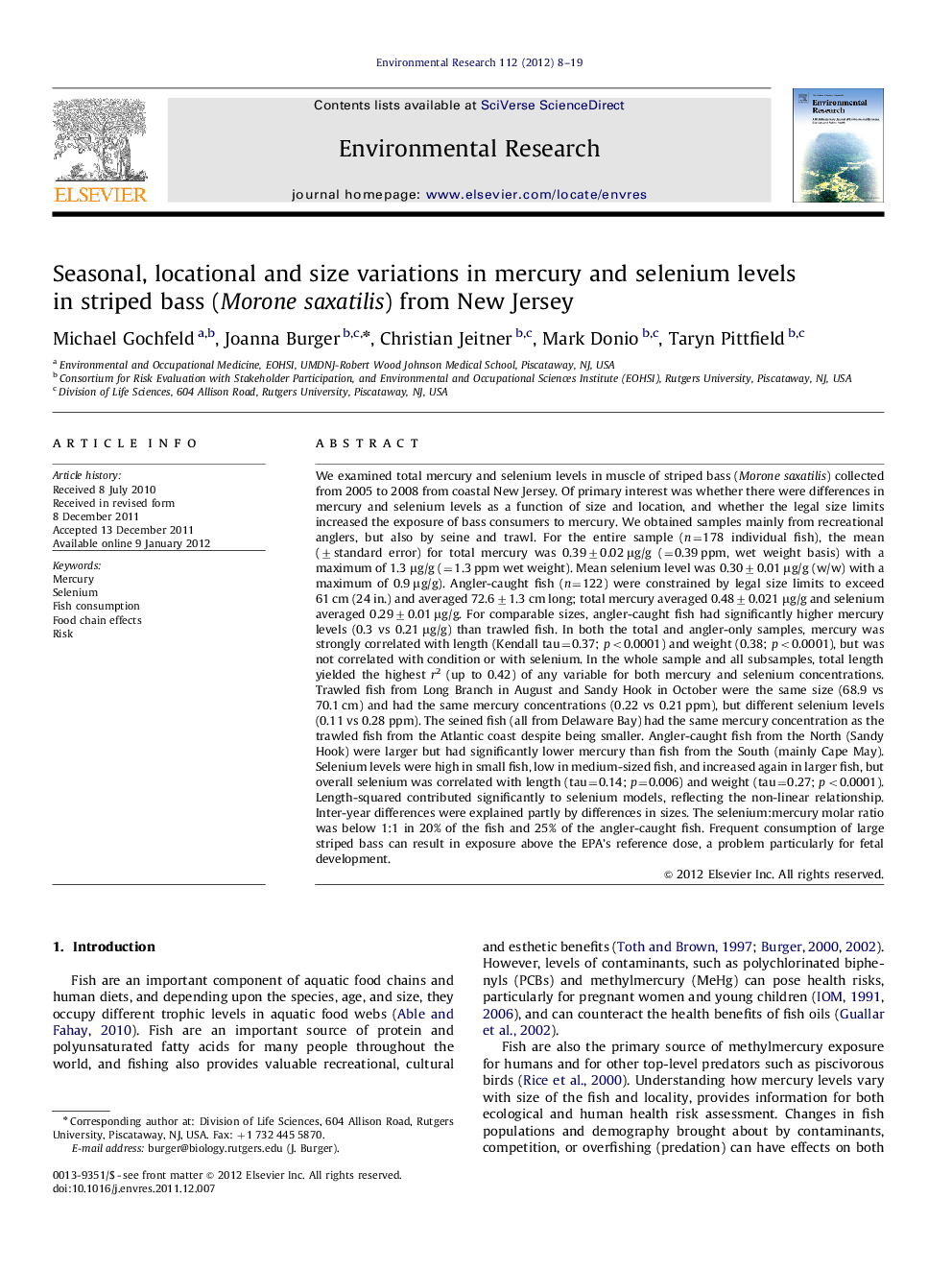| کد مقاله | کد نشریه | سال انتشار | مقاله انگلیسی | نسخه تمام متن |
|---|---|---|---|---|
| 4470140 | 1622589 | 2012 | 12 صفحه PDF | دانلود رایگان |

We examined total mercury and selenium levels in muscle of striped bass (Morone saxatilis) collected from 2005 to 2008 from coastal New Jersey. Of primary interest was whether there were differences in mercury and selenium levels as a function of size and location, and whether the legal size limits increased the exposure of bass consumers to mercury. We obtained samples mainly from recreational anglers, but also by seine and trawl. For the entire sample (n=178 individual fish), the mean (±standard error) for total mercury was 0.39±0.02 μg/g (=0.39 ppm, wet weight basis) with a maximum of 1.3 μg/g (=1.3 ppm wet weight). Mean selenium level was 0.30±0.01 μg/g (w/w) with a maximum of 0.9 μg/g). Angler-caught fish (n=122) were constrained by legal size limits to exceed 61 cm (24 in.) and averaged 72.6±1.3 cm long; total mercury averaged 0.48±0.021 μg/g and selenium averaged 0.29±0.01 μg/g. For comparable sizes, angler-caught fish had significantly higher mercury levels (0.3 vs 0.21 μg/g) than trawled fish. In both the total and angler-only samples, mercury was strongly correlated with length (Kendall tau=0.37; p<0.0001) and weight (0.38; p<0.0001), but was not correlated with condition or with selenium. In the whole sample and all subsamples, total length yielded the highest r2 (up to 0.42) of any variable for both mercury and selenium concentrations. Trawled fish from Long Branch in August and Sandy Hook in October were the same size (68.9 vs 70.1 cm) and had the same mercury concentrations (0.22 vs 0.21 ppm), but different selenium levels (0.11 vs 0.28 ppm). The seined fish (all from Delaware Bay) had the same mercury concentration as the trawled fish from the Atlantic coast despite being smaller. Angler-caught fish from the North (Sandy Hook) were larger but had significantly lower mercury than fish from the South (mainly Cape May). Selenium levels were high in small fish, low in medium-sized fish, and increased again in larger fish, but overall selenium was correlated with length (tau=0.14; p=0.006) and weight (tau=0.27; p<0.0001). Length-squared contributed significantly to selenium models, reflecting the non-linear relationship. Inter-year differences were explained partly by differences in sizes. The selenium:mercury molar ratio was below 1:1 in 20% of the fish and 25% of the angler-caught fish. Frequent consumption of large striped bass can result in exposure above the EPA's reference dose, a problem particularly for fetal development.
► Mercury strongly correlated with fish length and weight.
► Selenium correlated with fish length and weight.
► Se:HG molar ratios decreased with size of fish.
► Frequent consumption of large bass can result in exposure above EPA's reference dose.
Journal: Environmental Research - Volume 112, January 2012, Pages 8–19